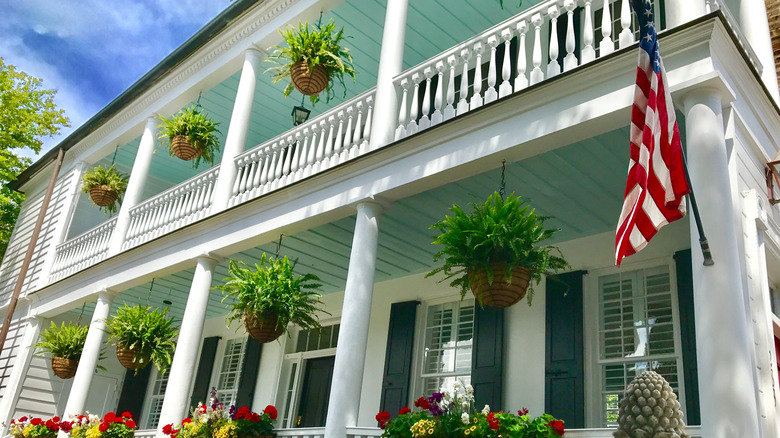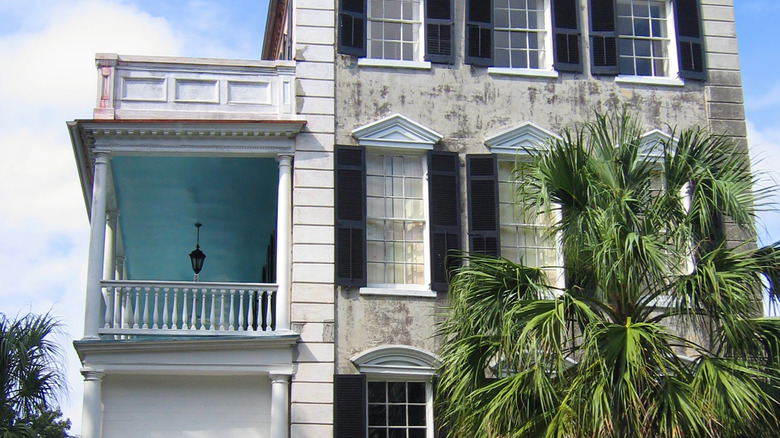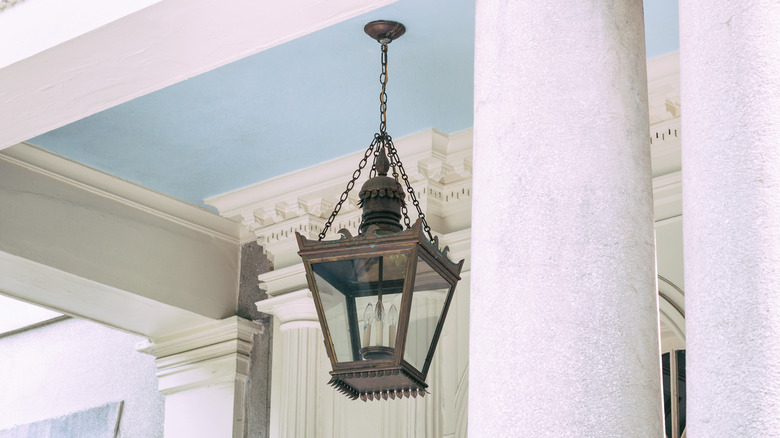The Real Reason People In The South Paint Their Porch Roofs Blue
Wandering around a neighborhood in towns and cities in the South like Charleston and Savannah, you might notice a number of houses with porch roofs that are painted a light shade of blue. Known as the "low country," this region is a lowland coastal area in the South of around 200 miles encompassing South Carolina, Georgia, and North Florida, How Stuff Works writes. The blue color, known as "haint blue," is a tradition brought to the area by the Gullah people; they were enslaved people brought from West Africa, particularly from Sierra Leone. They were forced to grow indigo and rice, two of Charleston's greatest exports at the time, and then eventually cotton after the invention of the cotton gin.
The term haint, potentially related to the word haunt, is a Gullah term for a ghost, or more specifically, a restless spirit. But they aren't ghosts in the way that most Westerners think of them. Rather, they were tricksters — at times witch-like — lost souls left behind on Earth that were sometimes malevolent, but often times malicious. According to lore, a haint could enter a home through any opening, be it a door, a window, or even through something as small as a keyhole (via Tales of southern Haints).
The blue paint was meant to repel ghosts
A local tour guide in Charleston at the Palmetto Carriage Works explained on a recent tour that the belief of the Gullah people was that ghosts couldn't cross water. The thought was the blue painted porches would confuse the spirits, making them think that the porch ceilings were surrounded by water, or even underwater, and therefore keep them away from the home, protecting its residents. Genteel & Bard notes that it was even hoped to even deter death itself. But it was more than just the porches they painted; according to Taste of Home, the Gullah people painted windows, doors, and shutters in haint blue in an effort to ensure all evil spirits were repelled.
While commonly aqua, sky blue, or robin's egg blue, any light blue color would be considered protective, The Augusta Chronicles notes. The paint itself was made by mixing blue from the indigo plant with a lye-based whitewash, which while not particularly colorfast, would have resulted in something resembling chalk paint or milk paint.
While the tradition began with the Gullah people, Genteel & Bard notes that eventually colonists adopted the practice of painting the porches, more for the aesthetic appeal of the blue color than in hopes of protecting the home from evil spirits.
The blue paint actually has a potentially real repellant use
While there's no guarantee that the blue paint would deter ghosts, in an ironic twist, the blue color in the past did actually help deter disease-carrying insects like mosquitos. AL.com notes that modern local lore states that blue confuses birds and insects into making it seem as if the blue porch was actually the sky, so that would somehow make them stay away. However, according to a Sherman Williams article on the history of blue paint, it might actually have more to do with the chemical content of the historical paint than any sort of insect or animal instinct. "When blue paints were first used on ceilings, they were usually milk paints, and those paints often had lye mixed into the composition. Lye is a known insect repellent, which would explain why insects would avoid nesting on a painted porch ceiling or ledge," the article writes (via AL.com).
That said, many people in the low country still feel that the blue color works in deterring critters. As The Dust Doctor experienced, "At least two seasons ago we painted the ceilings of eaves and porches at home and at the office with haint blue paint ... I hadn't noticed until recently how clean these surfaces are — very few insects, no webs or nests of any kind. This haint blue idea really works."


